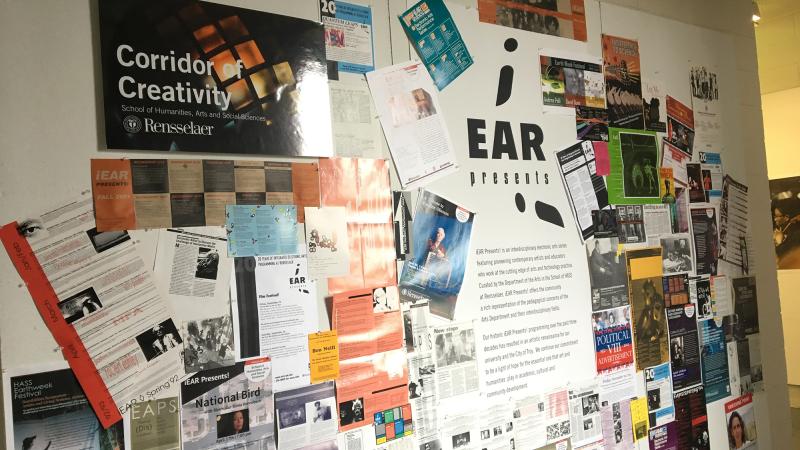Re-imagined hallway offers glimpse at HASS projects
November 28, 2017

The School of Humanities, Arts, and Social Sciences (HASS) has transformed two cinderblock hallways of the Sage Labs into the Corridor of Creativity, a place where visitors can view the latest student projects and catch a glimpse of innovation in action.
Posters, sketches, and other artwork now grace the walls on the first and second floors of Sage Labs. Sculptures occupy strategic spaces, and postings on the “Wall of Opportunity” invite students to collaborate on startups and other ventures. Once-solid walls now include large windows that compel passersby to pause to watch inventors, animators, and designers at work in studios, classrooms, and labs.
For HASS Dean Mary Simoni, one of the most important results of the redesigned space is the interaction it fosters among students from different disciplines.
“Any student can use any space—woodworking shop, 3-D printing lab, game development studios,” she said. “Now, students in science and technology are working side by side with students in sculpture, building a community around creation and discovery. That’s a beautiful thing.”
The Corridor of Creativity has become part of every admissions tour to introduce parents and prospective students to a lesser-known side of Rensselaer. October visitors—including those on campus for Reunion & Homecoming 2017—saw exhibits from classes including Basic Drawing, Intermediate Drawing, Typography, Visual Literacy, and Design for Global Society.
One poster promoted the Art_X Symposium of Music, Sound, and Mathematics at Rensselaer. Another poster presented “3-D Printing As Humanistic Inquiry,” research led by HASS Assistant Professor James Malazita and Associate Professor Dean Nieusma. The project is funded with a grant from the National Endowment of the Humanities. Still another exhibit paid tribute to the late Pauline Oliveros, distinguished research professor of music at Rensselaer and founder of the practice of “deep listening.”
The story behind the corridor is quintessentially Rensselaer. It begins with a student who came to Simoni concerned about the lack of space to display posters and other artwork to support the academic program. Simoni knew other students shared that concern. She also knew that there simply weren’t enough resources to provide separate space for every program.
Simoni saw a chance not only to turn a problem into an opportunity but also to reinforce what she considers “a philosophical imperative.” She was determined to find a place where students could showcase their accomplishments while benefiting from each other’s differing perspectives.
The solution came to her one morning, during her usual walk from West Lot to her office in Sage Labs. As she passed the cinderblock walls on the first and second floors, Simoni’s thoughts turned to the activity those walls were hiding. “There was so much going on behind them,” she said. “If we could blast through some of those walls and install glass, we could see into the studios.”
From that germ of an idea came a renovation that also provided exhibit space and—with a $500,000 grant from the Lemelson Foundation—established the state-of-the-art Burt Swersy Inventors Studio.
“It became a multiyear facilities renovation plan to update, repurpose where necessary, and create more interconnectivity in the entire corner of those two levels of the building,” Nieusma said. “Behind all that cinderblock, highly engaged, interactive design work was going on. We made that work visible.
“We took an underutilized space and revitalized it,” he added. “Instead of plain cinderblock hallways, we have cinderblock halls punctuated with points of excitement, energy, and creativity.”